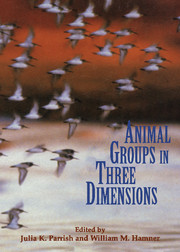Book contents
- Frontmatter
- Contents
- List of contributors
- Acknowledgments
- 1 Introduction – From individuals to aggregations: Unifying properties, global framework, and the holy grails of congregation
- Part one Imaging and measurement
- Part two Analysis
- Part three Behavioral ecology and evolution
- 11 Is the sum of the parts equal to the whole: The conflict between individuality and group membership
- 12 Inside or outside? Testing evolutionary predictions of positional effects
- 13 Costs and benefits as a function of group size: Experiments on a swarming mysid Paramesopodopsis rufa Fenton
- 14 Predicting the three-dimensional structure of animal aggregations from functional considerations: The role of information
- 15 Perspectives on sensory integration systems: Problems, opportunities, and predictions
- Part four Models
- References
- Subject index
- Taxonomic index
13 - Costs and benefits as a function of group size: Experiments on a swarming mysid Paramesopodopsis rufa Fenton
from Part three - Behavioral ecology and evolution
Published online by Cambridge University Press: 01 June 2010
- Frontmatter
- Contents
- List of contributors
- Acknowledgments
- 1 Introduction – From individuals to aggregations: Unifying properties, global framework, and the holy grails of congregation
- Part one Imaging and measurement
- Part two Analysis
- Part three Behavioral ecology and evolution
- 11 Is the sum of the parts equal to the whole: The conflict between individuality and group membership
- 12 Inside or outside? Testing evolutionary predictions of positional effects
- 13 Costs and benefits as a function of group size: Experiments on a swarming mysid Paramesopodopsis rufa Fenton
- 14 Predicting the three-dimensional structure of animal aggregations from functional considerations: The role of information
- 15 Perspectives on sensory integration systems: Problems, opportunities, and predictions
- Part four Models
- References
- Subject index
- Taxonomic index
Summary
Introduction
Congregation is a common behavioral trait among pelagic crustaceans. The benefits of such swarming behavior are generally assumed to be the same as those proposed for fish schools, i.e. protection from predators, improvement in feeding and foraging efficiency, efficiency in energy expenditure, and reproductive facilitation (Wilson 1975; Miller & Hampton 1990; Ritz 1991). Several studies have indicated that planktonic aggregations serve reproductive functions (gelatinous zooplankton – Hamner & Jennsen 1974; Hernroth & Grondahl 1985a,b; euphausiids – Hanamura et al. 1989). It is much less clear whether congregating also confers more long-term benefits, such as antipredation or foraging, or whether one is traded off against the other (i.e. life before dinner principle). Rigorous testing of the costs and benefits of congregative behavior in aquatic invertebrates has lagged a long way behind that for fish. The reason is partly due to the relatively new realization that the larger so-called planktonic animals are not the passive particles they had formerly been believed to be (Omori & Hamner 1982; Hamner 1985, 1988; Ritz 1991, 1994). For example, many undertake extensive diel vertical migrations that serve to protect themselves from predators in surface waters. Also many have evolved a range of active escape responses which are manifested when a predator attacks (Ohman 1988; see below). Several authors have reported that congregations persist despite turbulent water conditions and predatory attacks (e.g. Wittmann 1977; Kawamura 1974; Modlin 1990).
Information
- Type
- Chapter
- Information
- Animal Groups in Three DimensionsHow Species Aggregate, pp. 194 - 206Publisher: Cambridge University PressPrint publication year: 1997
Accessibility standard: Unknown
- 7
- Cited by
